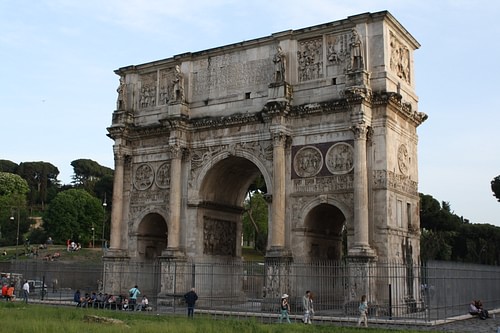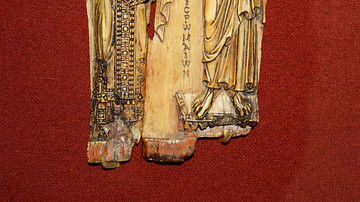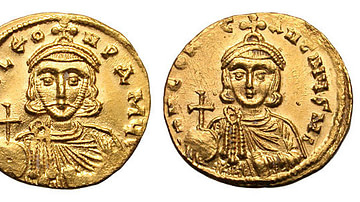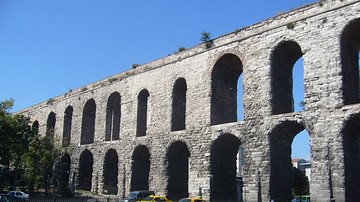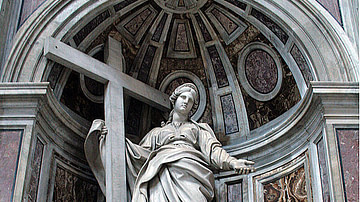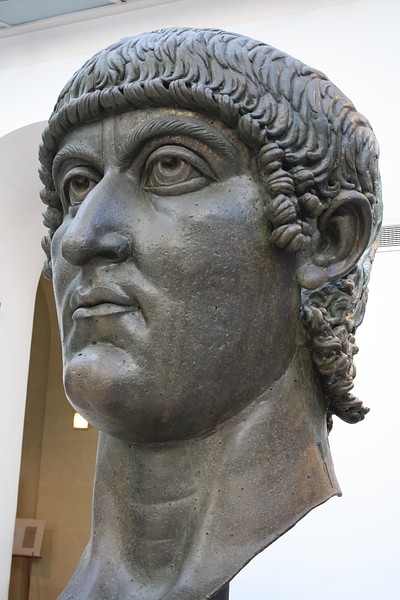
Constantine I, aka Constantine the Great, was Roman emperor from 306 to 337 CE. Realizing that the Roman Empire was too large for one man to adequately rule, Emperor Diocletian (284-305 CE) split the empire into two, creating a tetrachy or rule of four. While he ruled the east from Nicomedia as an “augustus” with Galerius as his “caesar,” Maximian and Constantius the Pale ruled the west. It was the son of Constantius, Constantine, who would one day rise to defeat all challengers to the throne and reunite the split empire, moving the capital away from Old Rome and build a new eastern capital, a capital that one day would bear his name, Constantinople.
Early Life
Although sources vary on the exact year of his birth, Constantine (Gaius Flavis Valerius Constantinus) was born at Naissus in present-day Serbia as early as 272 CE or as late as 285 CE. Since his father was not only a military commander but also the caesar of the west, Constantine lived his entire early life in the imperial court, eventually serving as a high-ranking staff officer for Diocletian. Even in his youth, those around him saw Constantine as a man of boundless energy. Under the emperor's tutelage, he learned that a ruler's job was to defend the empire from any external force and create a just and ordered society - something Constantine would put into practice when he became emperor himself.
In May of 305 CE, the senior emperors Diocletian and Maximian both abdicated their thrones to Galerius in the east (with Maximinus Daia as caesar) and Constantius in the west (with Falvius Valerius Servius as caesar). These appointments were not popular with everyone. Maxentius, the son of Maximian, and Constantine felt betrayed, each believing he deserved the appointment as caesar. This omission would not be forgotten and would eventually lead to a long, bitterly fought battle over control of both halves of the empire. After Diocletian abdicated, Galerius (in an attempt to appease bitter feelings) permitted the disappointed Constantine to return to the west in 306 CE to serve under his father. Before Constantius succumbed to leukemia (the reason he was called “the Pale”) in July of 306 CE at York, Constantine had the opportunity to campaign with his father in Britain against the Picts. It was in Britain that the newly appointed augustus earned the title “Britannicus Maximus” for the second time.
After his father's death Constantine continued to build a reputation as a man capable of rapid and decisive action when in 307 CE he attacked the Franks. It was here that he proved he could act without mercy when he killed two Frankish kings by throwing them to beasts in the amphitheatre at Trier (Augusta Treverorum). However, he could also show compassion as when he restored church property that had earlier been confiscated. Slowly he gained the respect of the army, demonstrating to his men, even those older and more experienced, they could trust him.
With the death of Constantius and the success of the war in Britain, many expected Constantine to be named the new western emperor; however, Severus (caesar and close friend of Galerius) was promoted to the position, despite the claim that Constantius had named his son as augustus on his deathbed. Regardless of the official decree, Constantine was declared augustus by his men. Galerius, however, refused to recognize this declaration, naming himself caesar instead. Not to be overlooked, Maxentius, who had also been overlooked in 305 CE, ignored both Galerius and Constantine and declared himself augustus in October of 307 CE. With the support of the people of Rome and the Praetorian Guard, he controlled Sicily, Corsica, Sardinia, and parts of North Africa. Eventually, as many as six different people would eventually claim control in the west.
Because of his friendship to Galerius, Severus was distrusted by both Constantine and Constantine's brother-in-law Maxentius, and in order to defeat the new augustus, they allied themselves with the former augustus Maximian and joined forces against Severus. Unfortunately for Severus, who had received orders to stop Maxentius, his army deserted him (having been bribed by Maxentius). Fearing for his life, he fled to Ravenna, only to be captured and killed outside Rome. His death prompted Galerius to unsuccessfully invade the west with an army. In 308 CE a new tetrachy was formed (with the advice of Diocletian) with Licinius (an Illyrian army officer and friend of Galerius) as the new augustus and Constantine retaining his position as the caesar. To add to the confusion, Maximian (who had been living at Constantine's court as an advisor) came out of retirement in 310 CE, announcing himself as the new augustus, claiming Constantine was dead. Constantine, who had been away fighting the Franks, hunted him down outside Marseilles (the city had refused to grant him assistance), and in desperation Maximian hanged himself.
Meanwhile, Maxentius's tenure in Rome was waning. He had lost his popularity with the citizens of Rome - overtaxing them in order to build a new basilica and a large statue of himself. His contempt for the people had resulted in a series of riots which only ended with the massacre of several thousand Romans. Constantine waited patiently and watched as the empire in the west began to self-destruct then, gathering an army of forty thousand, he crossed the Alps and invaded Italy.
Constantine Becomes Emperor
With little support in the city, Maxentius left Rome to meet Constantine in one final, crucial battle - the Battle of Milvian Bridge in 312 CE. On the day before the battle began, Constantine reportedly looked to the sky where he saw a cross of light. Under it was the inscription In Hoc Signo Vinces or “in this sign, conquer”. That night, in a dream, he received an explanation of the sign - Jesus Christ appeared before him telling him to carry the sign of the cross into battle. The following day old banners were replaced with new ones displaying the Christian symbol. Although outnumbered, Constantine easily defeated Maxentius who fled back to Rome, however, before reaching the city, he fell into the river and drowned; his body was discovered the next morning among the corpses of many others. Constantine's conversion to Christianity is seen by historians as a turning point in history, a fusion of church and state. Constantine immediately assumed complete control of the west. As the new augustus in the west, he marched into Rome; one of his first acts was to issue the Edict of Milan, a toleration of all religions (it would later be co-signed by Licinius).
Galerius was serving as the eastern emperor, with and Maximinus Daia as caesar. After Galerius died from cancer (on his deathbed he rescinded all anti-Christian edicts), Maximinus and Licinius fought for control of the east, eventually splitting that part of the empire between them - Licinius got the Balkans while Maximinus got Asia Minor and the eastern provinces. This arrangement was not to last and in 313 CE the two fought on the plains of Thrace. Like Constantine at Milvian Bridge, Licinius fought under the sign of the cross; however, he did it not because of his faith but only to gain the support of the Christians; his opponent, Maximinus, had promised to eradicate them. Despite inferior numbers, Licinius was victorious, and after the suicide of Maximinus, seized control of the east. To be safe and secure in his right to the throne, he immediately executed the sons of both Galerius and Severus, the family of Maximinus, and even Diocletian's daughter.
An uneasy truce existed between Licinius and Constantine, partially because Licinius had married Constantine's half-sister Constantia. In their first meeting on the battlefield In October of 316 CE Constantine defeated him at Cibalae. A second battle near Hadrianopolis ended with land cessions in the Balkans to Constantine. Over the next few years, Licinius's attitude towards the Christians changed with both executions and the destruction of several Christian churches. This was enough to prompt Constantine to gather an army and defeat Licinius in a second battle at Hadrianopolis. The defeated commander fled the battlefield, escaping against the Bosporus. In September of 324 CE Licinius was finally defeated at Chrysopolis and surrendered. Licinius hoped to return to life as a private citizen which Constantine initially granted, but he went back on his word, and Licinius was hanged in 325 CE - even his nine-year-old son was killed. Constantine's victory would reunite the empire.
Byzantium
The 52-year-old Constantine was now the sole emperor of the empire, and with it, a sense of stability returned. Constantine realized that Old Rome was not the city he wanted for a capital, and despite several of the building projects he instituted, it was decaying. Rome was no longer practical (Constantine even disbanded the Praetorian Guard), and Nicomedia was never considered, for it had been the capital of Diocletian. A new capital was needed, and although he thought about the site of ancient Troy, Constantine finally saw what he wanted - Byzantium. The ancient city was strategically located on the European side of the Strait of Bosporus, so it would control traffic to and from the Black Sea. It also provided an excellent harbor (The Golden Horn) and, therefore, could be easily defended.
To rebuild the city into the one in his vision, he brought in artisans and resources from across the empire. There were wide avenues with statues of Alexander, Caesar, Augustus, Diocletian, and of course, Constantine. He rebuilt the walls, built cisterns, Christian churches (Hagia Irene), and pagan temples. It was a Christian capital that remained classical at the same time. In 330 CE the city was finally dedicated.

Constantine & Christianity
During his years of warfare in the west he had always demonstrated religious tolerance with both pagans and Christians (he claimed to be a Christian since 312 CE). His mother Helena was a devout Christian, and after Constantine became emperor, he sent her on a pilgrimage to the Holy Land where she had built the Church of the Nativity at Bethlehem. Although he had been a worshipper of the sun-god in his youth and while some claim he did not become baptized until his deathbed, he still gave every indication that he was a devoted Christian. He is even credited by many historians with making Christianity the official religion of the empire (although others credit Emperor Theodosius), despite the fact that pagan symbols of Sol Invictus and Mars appeared on his coins. While he tolerated certain pagan religious practices, religious freedom had its limits, pagan sacrifices were forbidden, temple treasures seized, gladiatorial contests ended (Christians disliked them), crucifixions were abolished, and laws were enacted against sexual immorality and ritual prostitution.
In 325 CE Constantine invited clerics from across the empire to the Council of Nicaea where he made a plea for unity. The result of the conference was not only a condemnation of Arianism but also the Nicene Creed, a definition of what it meant to be a Christian. One year later, in 326 CE, Constantine had his religious faith tested when he had his own son Crispus (from his first wife Minervina) killed - falsely accused of adultery. According to sources, Constantine's second wife Fausta made the accusations against Crispus, who had fought beside his father and governed the western provinces, because she was in love with him but he had rejected her. She later committed suicide when it was proven that the accusations were false. Constantine regretted the action for the remainder of his life.
Death
Constantine the Great maintained his role as a military commander, fighting the Alemanni in 328 CE with the assistance of his son Constantius II, defeating the Goths in 332 CE by starving them into submission, and lastly, capturing lost territories from the Dacians (territories that were later lost after his death). His last wish was to conquer neighbouring Persia after their king Shapur II had invaded Armenia. However, it was not to be. In 337 CE Constantine fell ill and died. He had ruled for 31 years. He was buried at the Church of the Holy Apostles in Constantinople, leaving his empire in the hands of his three sons - Constantine II, Constantius II, and Constans with Constantius II eventually defeating his brothers and ruling the entire empire by himself.

